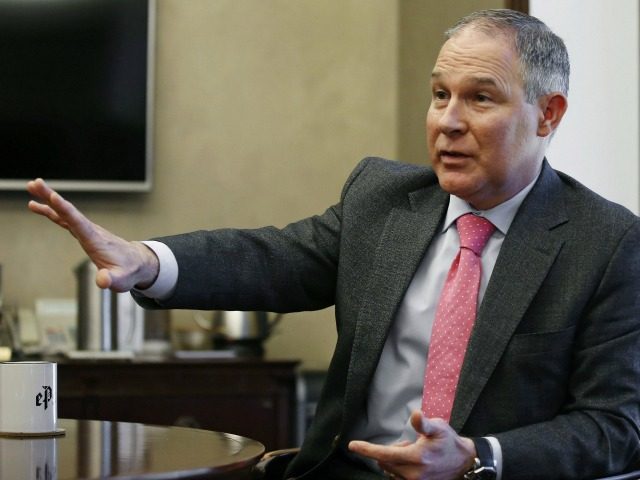Two pieces of excellent news from the Environmental Protection Agency (EPA) show that incoming administrator Scott Pruitt is doing the Lord’s work.
First, he has come clean and said what he should have ‘fessed up to a while back: he doesn’t believe in the Carbon Fairy.
Asked his views on the role of carbon dioxide, the heat-trapping gas produced by burning fossil fuels, in increasing global warming, Mr. Pruitt said on CNBC’s “Squawk Box” that “I think that measuring with precision human activity on the climate is something very challenging to do and there’s tremendous disagreement about the degree of impact, so, no, I would not agree that it’s a primary contributor to the global warming that we see.”
That phrase, “the heat-trapping gas produced by burning fossil fuels,” is just a bit of New York Times editorializing, by the way. No serious person thinks that man-made carbon dioxide poses any kind of major climate threat because there’s just no evidence to support that theory. It’s just one of those cherished left-liberal myths that goes next to other fantasy concepts like “equality,” “sustainability,” and “social justice.”
Speaking of which, the second piece of good news is that the Environmental Protection Agency has just lost its head of Environmental Justice.
Probably you didn’t know that the EPA had a head of Environmental Justice, but you should because you’ve been paying his salary since the George H.W. Bush era. His name is Mustafa Ali, and, according to a tearful requiem in Inside Climate, he has resigned in protest at EPA budget cuts, which will see the agency lose 20 percent of its 15,000 staff and $2 billion from its $8 billion.
“Jumped before he was pushed” is the phrase that comes to mind, for it is likely that Ali’s department will be dismantled altogether.
Ali has written a resignation letter to Scott Pruitt saying what a mistake this would be.
But if you go to the EPA’s website and see what the Environmental Justice Department has been doing for the last few years, you may disagree with this assessment.
Check out this page About EJ 2020.
By the end, you’ll have no more idea what the Environmental Justice Department does than you did at the beginning.
Here’s a taste:
Through EJ 2020, EPA will advance our environmental justice efforts to a new level in improving the health and environment of overburdened communities. By 2020, we will:
- Improve on-the-ground results for overburdened communities through reduced impacts and enhanced benefits
- Institutionalize environmental justice integration in EPA decision-making
- Build robust partnerships with states, tribes and local governments
- Strengthen our ability to take action on environmental justice and cumulative impacts
- Better address complex national environmental justice issues.
Our vision of how EPA will make a difference in the environmental and public health landscape over the next five years is detailed on the key results page of the plan.
It is, as I think you’ll agree, pure gibberish. How do you measure this department’s success in advancing the cause of “environmental justice”? Well, of course, you don’t. You can’t because “environmental justice” is a nebulous concept, which can mean pretty much anything you want it to mean.
Reading between the lines, though, what you can guess is that it’s basically another race-guilt make-work scheme. It’s based on the (spurious, identity-politics-driven) notion that environmental problems are felt more keenly by people of color because they live in poorer areas more vulnerable to pollution.
Well, George H.W. Bush fell for it, clearly: it was under his administration in 1992 that the department was inaugurated. Not so, thank heavens, Donald Trump.
If you’re in any doubt that this was a department ripe for deep-sixing, listen to the sad words of former EPA administrator Gina McCarthy:
“I am heartbroken that Mustafa feels that his time of productivity in the agency has passed,” McCarthy said in an interview. “He managed the interagency working group on environmental justice,” she said, referring to a conclave of federal agencies that met to discuss common concerns. “So when I say we brought actions and strategies to the table, it wasn’t just EPA, it was throughout the federal government.”
Did any of these people do anything useful with all that taxpayer money they’ve been getting? Ever??

COMMENTS
Please let us know if you're having issues with commenting.